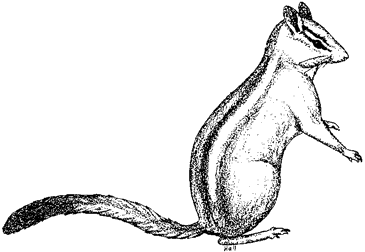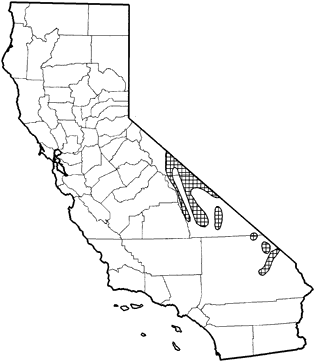
Panamint Chipmunk
Distribution, Abundance, and Seasonality
The Panamint chipmunk occurs along the eastside of the southern Sierra Nevada, and in the desert ranges of southern Mono Co. south to San Bernardino Co. It is a common, yearlong resident of pinyon-juniper and juniper habitats, residing primarily in rocky outcrops in these habitats. Ranges from 1700-2700 m (5700-9000 ft)

Range Map
Specific Habitat Requirements
Feeding: Primarily granivorous, but reported foods include pinyon and juniper fruits (Burt 1934), willow catkins (Hall 1946), seeds, fruits, green vegetation, arthropods, some lichens, bark, and carrion. Captive animals consumed 4-5.5 g of food per day (Hirshfeld 1975). Forages on ground, in shrubs, and trees. Probably caches.
Cover: Uses rocks and ground burrows for shelter and nesting. Probably uses the shade of trees and rocks for thermoregulation.
Reproduction: Uses rocks and ground burrows for nesting.
Water: Does not require a source of water other than food, but will use water if available.
Pattern: Primarily a rock dweller. Soil is thin in preferred habitat; fissured granite cliffs and ledges are abundant. Closely tied to presence of pinyon pine (Johnson 1940).
Species Life History
Activity Patterns: Diurnal. This species is a facuItative hibernator, depending on temperature and snow cover. May also show reduced activity in hot summer months.
Seasonal Movements / Migration: None reported.
Home Range: No data found.
Territory: Probably defends nest area. Possibly defends food concentrations, such as pinyon pines with heavy cone crops.
Reproduction: In Nevada, males are reproductively active between March and June; copulation probably occurs in April and May. Parturition occurs in late May to June and the young are weaned in August and September (Hirshfeld 1975). Gestation lasts about 36 days. Reported litter sizes range from 3-9, with averages of 3.8, 4.2, and 5.75 (Hirshfeld and Bradley 1977, Hirshfeld 1975, and Deacon et al. 1964, respectively). Young are hairless at birth, and become active above ground by 6 wk.
Niche: This small, diurnal omnivore occupies habitats similar to those occupied by T. amoenus along the east side of the Sierra Nevada south of Lake Tahoe. Possibly, like T. amoenus, it is precluded from sagebrush habitats because of low heat tolerance (Chappell 1978). T. panamintinus occurs parapatrically to T. minimus, which occupies open sagebrush habitat. Predators probably include raptors, weasels, coyotes, bobcats, and foxes.
Comments: This species is little studied in California.
Sources & References
California Department of Fish and Game, 1999.
California's Wildlife, Sacramento, CA.
Written by: J. Harris, reviewed by: H. Shellhammer, edited by: R. Duke
Brand, L. R. 1976. The Vocal Repertoire of Chipmunks (Genus Eutamias) in California. Anim. Behav. 24:319-335. Burt, W. H. 1934. The mammals of southern Nevada. Trans. San Diego Soc. Nat. Hist. 7:375-427. Chappell, M. A. 1978. Behavioral factors in the altitudinal zonation of chipmunks (Eutamias). Ecology 59:565-579. Deacon, J. E., W. G. Bradley, and K. M. Larsen. 1964. Ecological distribution of the mammals of Clark Canyon, Charleston Mountains, Nevada. J. Mammal. 45:397-409. Hall, E. R. 1946. Mammals of Nevada. Univ. California Press, Berkeley. 710pp. Hall, E. R. 1981. The mammals of North America. Second ed. 2 Vols. John Wiley and Sons, New York. 1271pp. Hirshfeld, J. R. 1975. Reproduction, growth, and development of two species of chipmunks: Eutamias panamintinus and Eutamias palmeri. M.S. Thesis, Univ. Nevada, Las Vegas. 84pp. Hirshfeld, J. R., and W. G. Bradley. 1977. Growth and development of two species of chipmunks: Eutamias panamintinus and E. palmeri. J. Mammal. 58:44-52. Ingles, L. G. 1965. Mammals of the Pacific States. Stanford Univ. Press, Stanford, CA. 506pp. Johnson, D. H. 1940. Systematic Review and Environmental Relations of California Chipmunks, Genus Eutamias. Ph.D. Thesis, Univ. California, Berkeley. 188pp. Johnson, D. H. 1943. Systematic Review of the Chipmunks (genus Eutamias) of California. Univ. Calif. Publ. Zool. 48:63-143.
California Animal Facts | California's Wildlife